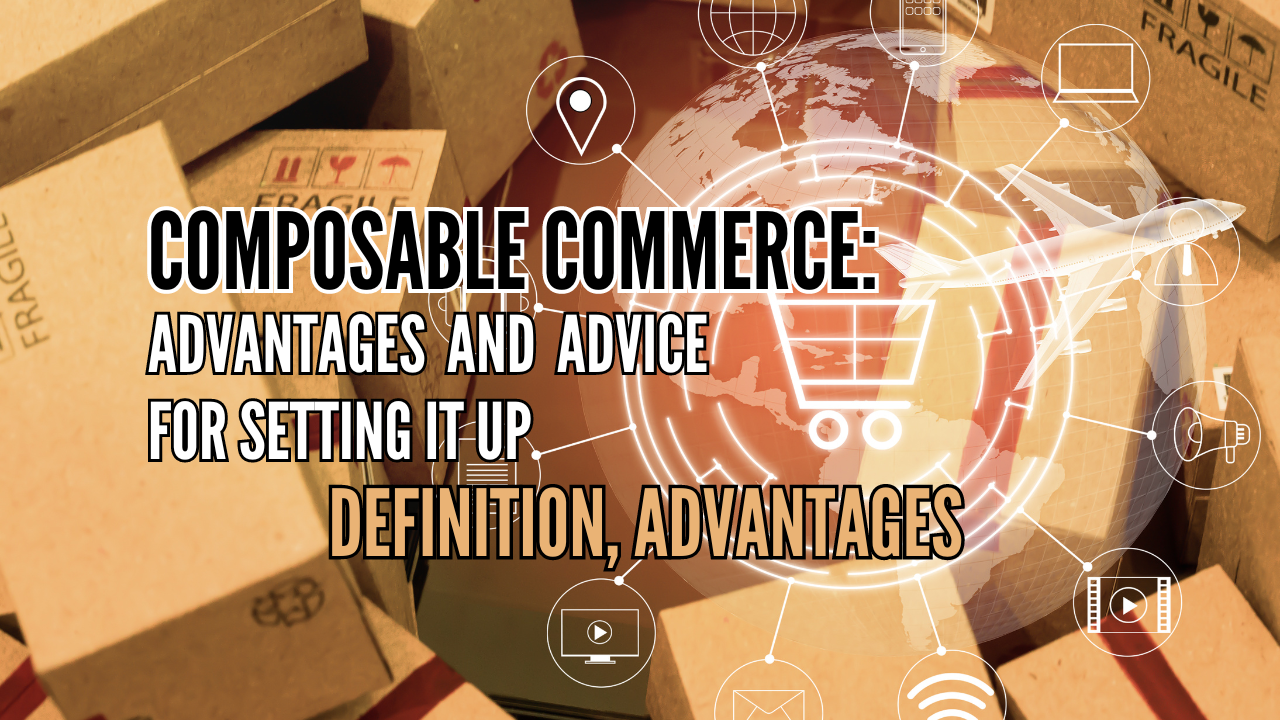
The world of e-commerce is in a constant state of evolution, continuously seeking ways to provide businesses with the flexibility and adaptability necessary to meet the changing needs of consumers. At the core of this revolution lies “composable commerce,” an innovative approach that redefines how e-commerce platforms are designed and operated, enabling businesses to build tailor-made solutions. In this article, we will delve into this new approach, its advantages, and offer practical tips for successful implementation.
What is Composable Commerce?
A Definition Composable commerce offers an innovative approach to e-commerce and information systems (IS) by enabling the breakdown of various functionalities of an e-commerce platform into interchangeable modules or components. Instead of relying on “one-size-fits-all” solutions, composable commerce allows businesses to select, assemble, and reorganize these components (also known as “packaged commerce capabilities,” PCC) according to their specific needs, akin to LEGO bricks. This approach provides them with considerable adaptability.
“Headless Commerce” vs. “Composable Commerce”: What’s the Difference?
In the realm of e-commerce, the terms “headless” and “composable” are frequently mentioned. However, they refer to distinct yet closely related concepts. Understanding their specifics is crucial when choosing the most suitable solution for your needs.
- “Headless commerce” refers to an architecture where the “head” (i.e., the presentation or front-end layer) is separated from the “body” (the back-end). This separation enables businesses to design customized user experiences across any channel (web, mobile, IoT, etc.) while using a single back-end. As a result, the user interface can be updated, modified, or redesigned without disrupting systems that manage products, payments, or any other back-end functionality.
- “Composable Commerce” (or Composable Commerce in French) is based on breaking down the various functionalities of an e-commerce platform into interchangeable modules or components. Each component operates autonomously and handles a specific function, such as payment management, product recommendations, or logistics. The advantage lies in businesses being able to select, assemble, and rearrange these modules according to their specific needs.
So, what’s the fundamental difference? Put simply, while headless commerce focuses on separating the front-end and back-end, composable commerce allows flexibility and interchangeability of all the platform’s components.
Packaged business capabilities: what is it?
Packaged Commerce Capabilities (PCC) refer to the comprehensive set of preconfigured tools, functionalities, and services offered by an e-commerce solution to meet the varied needs of e-commerce businesses. A composable commerce solution consists of these PCC, assembled through a unifying API. These capabilities can be sourced from the same provider or different providers, and each PCC is equivalent to a software component designed to fulfill a specific commercial function. The “packs” of PCC are generally designed to facilitate the implementation of specific operations or strategies.
In essence, Packaged Commerce Capabilities refer to the ready-to-use resources that e-commerce businesses can leverage when using a particular e-commerce platform. Marketing tools, inventory management, payment methods, logistics, and even customer service: Packaged Commerce Capabilities can streamline the tasks of e-commerce businesses across various domains. Businesses can review these capabilities in different PCC catalogs and choose the ones that best suit their needs.
Here are a few examples of Packaged Commerce Capabilities:
- Storefront
- Catalog
- Promotions
- Shopping Cart
- Checkout Process
- Payment
- Search
Advantages of Composable Commerce in 2023
- Tailored Customer Experience
- Accelerated Innovation
- Optimized Costs
- High Operational Efficiency and Flexibility
- Long-lasting Environment
Tailored Customer Experience
Adopting composable commerce allows you to personalize every aspect of the shopping experience based on your customers’ specific needs. Leveraging the modularity enabled by composable architectures, businesses can adjust functionalities, design, and various touch-points to offer a unique and relevant user experience. For instance, offering personalized product recommendations and tailored content based on their interests. This approach leads to improved customer satisfaction, loyalty, and ultimately increased sales.
Accelerated Innovation
The modular approach of composable commerce, being an innovation in itself, enables businesses to adapt more swiftly to market changes and new trends. Rather than rethinking and rebuilding the entire system each time, businesses utilizing composable commerce can simply add, remove, or modify necessary modules. This allows brands to integrate the latest innovations more easily, staying competitive and at the forefront of technology.
Optimized Costs
Through its reliance on Packaged Commerce Capabilities (PCC), composable commerce spares companies from managing expenses associated with designing and developing customized solutions. With composable commerce, businesses can eliminate the costs of developing a module while benefiting from a robust e-commerce infrastructure. Moreover, in cases where adjustments or feature modifications are required, operational costs are reduced as businesses aren’t starting from scratch.
High Operational Efficiency and Flexibility
Composable commerce provides brands with the freedom to choose and arrange modules that best suit their needs. This flexibility allows for the swift implementation of new strategies, easier integration of new technologies, and improved responsiveness to customer feedback. By offering a brick-like architectural flexibility, composable commerce allows brands to enjoy services perfectly tailored to their objectives and needs, offering unmatched operational agility.
Environment Designed for Longevity
Far from being a temporary solution or passing trend, composable commerce is built on the idea of longevity. Its brick-like architecture is designed to adapt and evolve with the changing needs of businesses and consumers. This agility ensures sustainability for brands, as the e-commerce platform can transform without major overhauls, ensuring its viability over the long term.
Challenges Presented by Composable Commerce
- A Certain Level of Complexity
- Maintenance
- Slower Market Entry
A Certain Level of Complexity
While composable commerce offers unprecedented flexibility, it also introduces complexity. Assembling different components from various suppliers can present integration challenges. Each module has its own architecture and logic, making it challenging to ensure seamless communication among them. However, ensuring a good integration among your various CCPs and services is crucial: these components should function together to provide consumers with a consistent end-to-end experience.
Implementing the multiple “bricks” of the composable architecture can be complex and time-consuming, especially if you and your team lack technical expertise. Each component may have its own set of contracts, APIs, data structures, and dependencies, which can be challenging to manage. Unless you’re a digitally mature company with an experienced engineering team, adopting a composable strategy may not be suitable for every brand.
Maintenance
With a composable commerce architecture, you’ll need to invest in each individual component of the solution, which, depending on the number of CCPs from different providers, can quickly lead to maintenance and update costs.
With a fragmented system composed of multiple modules, maintenance can become a significant challenge. In this context, it’s essential to ensure that each component is regularly updated and remains compatible with others. This ongoing monitoring may require substantial technical resources and more significant technological vigilance compared to other solutions.
Slower Market Entry
If your goal is a swift operational start, composable commerce might not be the best solution for your company. Although composable commerce offers long-term adaptability, the initial setup phase may take longer compared to “off-the-shelf” e-commerce solutions. In a composable architecture, the selection, integration, and customization of each component take time, delaying the effective launch of the platform.
How to migrate to composable commerce?
- Determine your business approach
- Brief your teams
- Initiate a company-wide reflection
- Proceed in multiple stages
Determine your business approach
Before delving into the realm of composable commerce, it’s crucial to clearly define your business objectives. What are the essential functionalities that your company needs? What type of customers are you targeting? What are your primary sales channels? By having a clear vision of your business strategy, you’ll be able to select modules that best suit the specific needs of your business.
Brief your teams
Ensure that all stakeholders, whether it’s the technical team or marketing and sales departments, understand the principle, the benefits offered, and the potential challenges posed by composable commerce. If adopting a composable strategy constitutes a significant change within your company, take the time to train your teams on the unique workings of composable architecture and inform them about its numerous advantages. Clear communication will enable better collaboration between teams and ensure that each component is optimally used within each department.
Initiate a company-wide reflection
Composable commerce involves not only the technical aspects of a company but also carries a strategic dimension. It’s crucial to involve all levels of the company in a comprehensive reflection that will allow everyone to make the most of this new organization. Organize workshops, meetings, or brainstorming sessions to gather the needs, concerns, and ideas of everyone involved. This approach will enrich your approach and contribute to generating greater buy-in for the project from all members of the company.
Proceed in multiple stages
As mentioned earlier, setting up a composable architecture takes time. Therefore, don’t try to do everything at once. Start by identifying the essential modules for your business and integrate them first. Once these are well-established and functional, gradually add other components based on the needs and feedback from different users. This step-by-step approach will allow you to more effectively manage potential challenges encountered and ensure a smooth transition to composable commerce.





